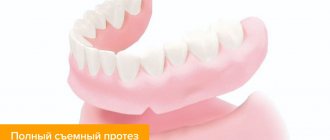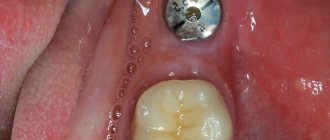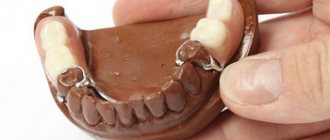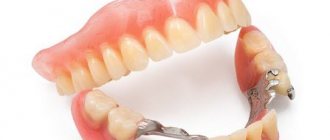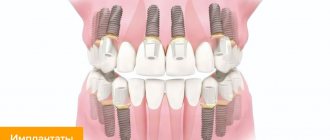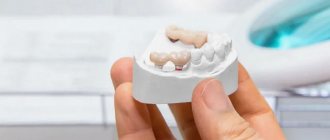All kinds of dental implants, or in other words, implants and implants, have firmly entered our lives and are no longer perceived as something unnatural. The invention of implantation - the implantation of artificial materials into the human body to replace lost organs - was a real breakthrough in medicine and science. Today, implants are used in many areas of medicine: these are artificial joints, silicone breast implants, and, of course, dental implants, which are available in almost every dentistry in Moscow.
History of the first patient
The first attempts to replace lost teeth with artificial ones were made by people in antiquity and even earlier. In the form in which we know dental implants now, they appeared in the second half of the 20th century. The first successful implantation was performed in 1965 on an ordinary carpenter, Gust Larsson, who lost all his lower teeth at the age of 34, had a cleft palate, a deformed upper jaw and chin, and experienced constant pain and significant difficulty eating and speaking. Larsson volunteered for a new study led by Professor Ingvar Brånemark at the University of Gothenburg, which Güsta had heard about by chance from his dentist. After the treatment, he was able to chew, eat and speak normally. The installed implants served Gust Larsson all his life. The experience of this brave man proved that installing dental implants is the most effective way to restore lost teeth.
Dental implants – what are they?
Dental implants, implants, implants are all artificial structures that replace missing teeth. They are firmly fixed in the bone tissue of the jaw and serve as a reliable support for fixed or removable dentures in the form of single crowns and bridges of varying lengths (you can see what dental implants look like in the photo above). There are several types of dental implants, but the most popular today are root-shaped dental implants, which have earned favorable reviews from both patients and leading implantologists around the world. Prices for dental implants depend on their quality, features of the installation system, the presence of special coating and other factors. Which implants are better is a topic for a separate article.
Photo of a dental implant
What is a quality implant?
From my point of view, a high-quality implant is an implant that is produced by a company that has been on the market for decades, which has a huge clinical base, which has randomized studies, and it’s not just that “my grandmother said that this implant is the best.”
Such companies - and these are Nobel, and Straumann, and Ankylos - have many years of research that show how much bone tissue loss occurs near the implant, for example, after five years, ten years, fifteen years. And before releasing something to the market, companies research it for a very long time, and all this goes through multi-stage testing.
The optimal metal used in all implants
This metal is titanium. And it should be noted that, for example, pure titanium takes root very well, but pure titanium is not mechanically strong enough. And therefore, the alloy that I mentioned, Roxolid from the Strauman company, is an alloy of titanium with zirconium, titanium is alloyed with zirconium. Zirconium is also a bioinert metal; it does not impair the quality of engraftment in any way, and by alloying titanium with zirconium, the strength increases many times over.
Can the composition of the implants further affect its survival rate?
Let's start with the fact that the implants we work with are all proven, and they are the best in the world today; their survival rate is almost one hundred percent on these systems.
There is a type of implant, there is a surface, there is a macrosurface, there is a microsurface.
Nobel implants have plasma spraying, Straumann has a SLActive surface, where the implant is first processed in several ways without access to oxygen, and then SLA implants are delivered to our clinics in special flasks filled with a patented solution, where, again, oxygen access to the implant is blocked.
In both Nobel and Straumann, due to what I described above, the process of osseointegration into the bones is faster.
Why a high-quality implant cannot be cheap?
A high-quality implant cannot be cheap because:
Firstly,
Enormous expenses have been invested in its development, in its clinical research, in its testing. Entire institutes test, experiment and observe how certain developments proceed in the future.
Secondly,
The technological chain for high-quality production of implants is a certain base, equipment, and stages. And in order for everything to be carried out at a high level, and for it to be done by highly qualified specialists, it cannot be cheap.
When I was studying at the Goethe University in Frankfurt (I took a year-long specialization), research at this university showed that inexpensive implant systems from little-known manufacturers often have surfaces contaminated with residues of mechanical processing, residues of chemical etching, and residues remaining on the surface of the implant. various salts. And the implant, in order for it to osseointegrate well into the bone, must have such a spongy 3D surface so that the bone adheres very well and grows into the body of the implant.
And this surface of inexpensive systems is not properly cleaned of impurities. And inexpensive competing manufacturers are trying to get the “same surface as well-known brands”, but the technological base or little research experience does not allow them to do this.
How do dental implants take root?
What material are dental implants made of? The answer to this question will help us understand why they take root well. Almost all of the newest dental implants are made from titanium. This unique material is ideal for the manufacture of artificial tooth roots, since it is not perceived by the human body as something foreign and is not itself subject to the destructive effects of the surrounding biological environment. But the most important thing is that it can reliably fuse with the jawbone. These unique properties of titanium solved the problem of rejection and made implantation a reliable and durable technique. However, in very rare cases when a patient is allergic to titanium dental implants, zirconium dioxide is used as a base to make the prosthesis.
How long does it take for a dental implant to take root? Experts believe that the survival of dental implants is an individual process. The timing of osseointegration depends on the area of the dentition in which the implantation was performed, as well as on the quality of the bone tissue. In general, the healing of dental implants lasts from three months on the lower jaw and up to six months on the upper jaw. If the implantation is successful, then removal of the prosthesis becomes almost impossible, which proves the reliability of the structure. What is the survival rate of dental implants that worries many patients? It varies among different manufacturers, but in general it does not exceed 5%. In addition, the success of the operation is also influenced by the skill of the implant surgeon, so the choice of dentistry should be approached with special care.
Selecting implants for the anterior teeth
Crowns are placed on rods that are implanted into the jawbone. They are not visible; outwardly they do not differ from living teeth.
When implanting teeth, the beauty of your smile depends on the type and price of the structure. When metal or bioceramic rods are installed in the jaw, the bone sags. This is not noticeable in the first year. The normal amount of atrophy is less than 1 mm per year for the first four years after prosthetics and 0.2 mm per year after 4-5 years. As the bone settles, it exposes the head of the rod; it is covered only by gum tissue. With constant contact with metal, it changes its color and acquires a bluish tint, which is clearly noticeable.
In order for the smile to remain beautiful and the gums to look healthy, when implanting incisors and canines, it is necessary to install structures that provide a minimum amount of atrophy: AstraTech (0.25 mm over 5 years) or Straumann (0.45 mm over 5 years). Most manufacturers do not indicate this indicator in the technical specifications. Independent studies were conducted, but not all models were included in them. And their performance from one manufacturer can vary greatly.
But it will not be possible to avoid atrophy when installing any model. To prevent gums from changing color, install a dental implant made of bioceramics to restore an incisor or canine.
If there is insufficient bone volume, implantologists recommend installing modern basal type dental implants ROOTT or Straumann.
Lifespan of dental implants
Although implantation is significantly more expensive than traditional prosthetics, with a long-term calculation the costs are equalized. This is due to the fact that traditional bridges, crowns, clasp or nylon dentures need to be replaced on average every 5 to 7 years, and the supporting teeth will have to be ground down again each time. How long does a dental implant last? The minimum service life of a dental implant is about 30 years, and if all the doctor’s instructions are followed, the implant will last you a lifetime. Most manufacturing companies, including world industry leaders, who invest considerable funds in the latest developments, provide a multi-year or even lifetime warranty on their products. This applies to the part of the structure that is located inside - that is, the root (base plate, etc.) and the abutment. A crown installed on an abutment has a more limited service life, but it is also significantly longer than that of a traditional prosthesis installed on ground natural teeth. This is on average 10 – 15, sometimes 20 years. If we are talking about implantation for a young person, then, of course, he will be interested in what happens to implants in old age. With proper care and preventive examinations, nothing should happen to the artificial root.
What is a pin and how is it different from an implant?
A pin is a rod that is installed into the root of a tooth. With its help, you can preserve the natural root and strengthen the crown part. Most often, this treatment method is used for severe tooth decay; the main condition for the procedure is strong root canals.
The pins are different:
- by material of manufacture (fiberglass, ceramics, metal, carbon fiber);
- by shape (cylindrical, conical, screw, cylindrical-conical);
- according to the method of fixation (screw, cement).
The doctor decides which pin to place depending on the specific situation.
Pin installation stage
- Removal of dental tissues affected by caries.
- Pulp removal.
- Preparing the dental canal for the installation of a pin.
- Trying on the rod.
- Procedures for treating the surface, channels, pin.
- Filling the channels with adhesive and fixing the pin.
Next, the crown part of the tooth is restored with filling materials or a crown if the tooth is destroyed by more than a third.
When is treatment with a pin not possible?
- root walls are destroyed;
- the root walls are not thick enough to install the pin;
- presence of gum disease;
- presence of a dental cyst.
General and specific contraindications
Who is contraindicated for dental implants? Implantation is a surgical operation and, like any other operation, it has contraindications. They are divided into two types: general for any type of implantation and specific dental ones.
The following concomitant diseases are common to all types of implantation (and to surgical interventions in general):
- violation of coagulation (blood clotting), diabetes mellitus, tuberculosis, chronic rheumatism - these diseases complicate wound healing and implant placement;
- pregnancy and lactation;
- childhood and adolescence – children and adolescents continue to grow, and this is fraught with displacement of implants or their rejection, or slowdown in the growth of individual organs as a result of the installation of dental implants in them;
- diseases of bone tissue that reduce its regenerative abilities;
- diseases of the nervous system;
- cancer during exacerbation, HIV and AIDS, specific diseases of the immune system that weaken the body as a whole and do not allow it to recover after operations.
The following can be considered specific contraindications to dental implantation:
- when installing implants in the upper jaw, it is necessary to take into account such factors as the proximity of the sinuses (aka the maxillary sinuses), as well as the width and density of the bone at the point of contact of the jaw with the sinuses; in some cases, the implantation procedure may be preceded by a sinus lift;
- chronic, including inflammatory diseases of the oral mucosa;
- patient's failure to comply with oral hygiene;
- insufficient height and density of bone tissue at the site of proposed implantation (this applies to both the upper and lower jaws) - in such a case, bone grafting can correct the situation.
It is worth noting that diabetes and advanced age are not currently included in the list of contraindications for dental implantation.
Dental implants in the upper jaw
Dental implants: types and prices in Moscow in 2022
The cost of a turnkey dental implant in Moscow includes the price of the design, surgery and abutment with a crown. It may differ in different clinics by 20-30%. When calculating how much it costs to install a dental implant, sometimes you need to add the costs of bone grafting and sinus lifting. They are done if the jaw bone does not have enough volume to accommodate an implant. But sometimes, instead of bone grafting, basal-type structures can be installed. Prices for turnkey dental implantation also depend on the type of prosthetics (removable, fixed) and crown material.
Premium designs include:
- Straumann - the price for a dental implant in Moscow starts from 65 thousand rubles when installed with a metal-ceramic crown, and from 90 thousand rubles if you choose a crown made of zirconium dioxide.
- Astra Tech - from 70 thousand rubles with a metal-ceramic crown, from 80 thousand - with a zirconium dioxide crown.
- NobelBiocare - from 80 thousand rubles with a metal-ceramic crown, from 90 thousand - with a zirconium dioxide crown, with fixed prosthetics for a toothless jaw - from 370 thousand (four implants are installed, a fixed prosthesis is attached to them), the dentition is completely restored.
Among budget designs, implantologists recommend:
- Roott-Form - how much does implantation of 1 tooth cost depends on the material of the crown, with a metal-ceramic crown - from 54 thousand, with a zirconium dioxide crown - from 63 thousand rubles.
- Roott - used to restore a group of adjacent teeth, installed when there is insufficient volume of jaw bone without bone grafting; how much dental implantation costs depends on how many implants need to be placed. Installation of 1 basal component costs from 35 thousand rubles. For fixed prosthetics of a toothless jaw (6-10 basal components and a bridge) – 230-325 thousand rubles, depending on the type of bridge.
- AlphaBio - from 35 thousand rubles with a metal-ceramic crown, from 50 thousand - with a zirconium dioxide crown.
- MIS – from 35 thousand rubles with a metal-ceramic crown, from 50 thousand – with a zirconium dioxide crown.
- Osstem - from 35 thousand rubles with a metal-ceramic crown, from 40 thousand - with a zirconium dioxide crown.
What else does the success of dental implantation depend on?
You can name the best dental implants in Moscow based on the totality of their characteristics. But the significance of the indicators for patients who are or are not included in risk groups, who are restoring incisors or molars, who are ready to wait three months for prosthetics, or who want to complete treatment in 1-2 weeks, is not the same. And if you also take into account how much a dental implant costs, then it will not be possible to give recommendations on the choice in absentia and in general terms. Discuss this issue with the dentist who will perform the operation.
It takes into account one more factor: the implantation technique:
- The classic two-stage method - having installed the rod, the doctor completely sutures the mucous membrane above it and creates sterile conditions for the implant to heal. When pathogenic bacteria multiply in the oral cavity, they will not enter the surgical field and will not cause inflammation. When the rod fuses with the jaw bone, the surgical damage heals, the second stage of the operation is carried out - opening the gum mucosa above it, removing the plug screw and installing the gum former. This method is recommended for smokers, the elderly, and people with weakened immune systems. But prosthetics are done after 3-6 months.
- One-stage - after installing the rod, the gum above it is not sutured, but a former is immediately placed. The gum contour is formed from the first days after surgery, but oral fluid enters the surgical field. The immune system of healthy people controls the growth of unwanted bacteria, and inflammatory processes do not develop. But, if the immune system is weakened, saliva contains carcinogenic substances obtained by inhaling tobacco smoke, the risk of inflammation and rejection of the implanted structure increases. Using this technique, a permanent bridge can be installed within 2-6 weeks. But it is not used if the patient is over 50 years old, smokes, has osteoporosis, diabetes, is prone to inflammatory processes on the skin, and frequent colds.
- Without delaying prosthetics - a temporary plastic crown is installed on the rod on the day of surgery, a few hours after implantation. It is used if one incisor or canine is missing in the dentition, and the patient experiences severe discomfort when communicating, or if his appearance is directly related to his ability to work.
- In case of complete absence of teeth, when installing basal structures in the deep layers of the jaw bone, a permanent bridge can be placed on the rods 1-3 days after the operation. The number of basal components is determined for each patient.
Caring for Dental Implants
Many patients who have had artificial teeth installed are concerned about the question: how to care for dental implants? In fact, caring for artificial teeth is practically no different from regular oral hygiene. The same few basic rules apply here: regularity, thoroughness, correctness. That is, you need to brush your teeth at least twice a day - in the morning and before bed, and preferably after every meal, especially after eating carbohydrates; this must be done for at least three minutes, and also use additional hygiene products: dental floss, irrigator, etc.; You need to brush your teeth correctly - with sweeping movements away from the gums. The same brushes that are used for cleaning natural teeth are suitable for cleaning dental implants, but you can purchase a special toothbrush for implants.
Which lasts longer: prosthesis or implant?
Dead teeth under crowns usually last no more than ten years. Over time, they are destroyed, which leads to the need to install new prostheses. The bridge needs to be replaced as the teeth in question decay. Removable plastic dentures require relining at least once a year. This is necessary to improve their fit to the gums. Cases of complete replacement of the structure are not uncommon.
The service life of the implant is not limited, but only if you properly care for the oral cavity. Even the best and most modern denture will not be durable if the patient rarely brushes his teeth. Improper care of the implant threatens its loss, as well as the development of an inflammatory process in neighboring tissues.
Dental implants – pros and cons
As for expert opinions, the majority of specialists are inclined to argue for dental implants, and those who are usually against are either very elderly doctors or dentists who do not have sufficient qualifications to carry out such procedures. If we consider the pros and cons of dental implants, then among the undeniable advantages we can note durability, the absence of the need to grind adjacent teeth, in contrast to the installation of bridges, as well as the preservation of all the functions of a natural tooth, such as: full participation in chewing and speech, prevention of tooth loss bone tissue and changes in facial features. As for the disadvantages, the price becomes a significant difficulty for most patients, however, as mentioned above, this is an adequate cost of solving the problem once for a lifetime. As for an alternative to dental implants, it does not exist as such, since traditional prosthetics is inferior to it in all respects.
Dental implants make it possible to improve the quality of life, restore the full functionality of the dentition, restore the attractiveness of the smile, and also protect yourself from the loss of bone tissue in the place of the missing tooth, and therefore from the possibility of losing neighboring teeth. But, in any case, only an implantologist can confirm the need for this operation; he will also help you draw up a treatment plan and choose designs that suit you personally.
Make an appointment:
1. Dental clinic on the street. 50 Let Oktyabrya, 24, office 2/2: Tel 2. Dental clinic on the street. Permyakova, 73: +7 3452 51-40-47
What is an implant
The first two terms have taken root in the Russian language. Doctors call a denture “implant” and “implantant,” despite the fact that the second option is incorrect.
An implant is a screw made of high-strength material with a diameter of 2-3 mm. This root is used to screw into the periosteum or bone where the molar was previously.
In the image it is indicated as a titanium root, which is the basis for attaching a dental crown.
The implant is indicated for use in a number of situations:
- The need for support for removable and fixed dentures;
- If you need to replace one extracted tooth;
- When the patient wants to maintain the aesthetic appeal of the smile and the teeth located next to the affected area.
In order to restore teeth using implants, it will take a lot of time, during which the patient goes through several stages:
- The doctor installs an artificial metal root;
- Damaged gum tissue should completely recover within a few months;
- A special structure called an “abutment” is implanted on top of the root; after two weeks, a ceramic or metal crown is installed on it.
Classic scheme
In modern dental clinics, the patient is offered an alternative restoration method - one-stage implantation (also called one-stage). Its peculiarity is that if with conventional prosthetics, the doctor expects the hole to completely heal, then here the implant is implanted immediately after removal - a titanium root is inserted into the cavity left after tooth extraction. As a rule, the duration of this method is only 7 days, during which the molar tooth will be removed and an implant will be installed in its place.
One-stage implantation
But before a titanium root is implanted, it is worth undergoing a high-quality examination by a dentist. During the examination, the doctor must examine in detail the condition of the oral cavity. If diseases are detected, treatment is mandatory. If this is not done, the titanium root will not take root and may cause the development of additional negative symptoms.
Products such as implants have many advantages, the main one being that there is no need to remove or grind down teeth to install dentures. In addition, with the help of implants, a single defect can be eliminated easily and in a short time.
It is believed that the absence of at least one tooth causes tissue looseness and the appearance of pathology such as mobility. Gradually, adjacent teeth will move towards the free space, resulting in gaps appearing between nearby elements. And this will provoke the occurrence of inflammatory and carious processes.
